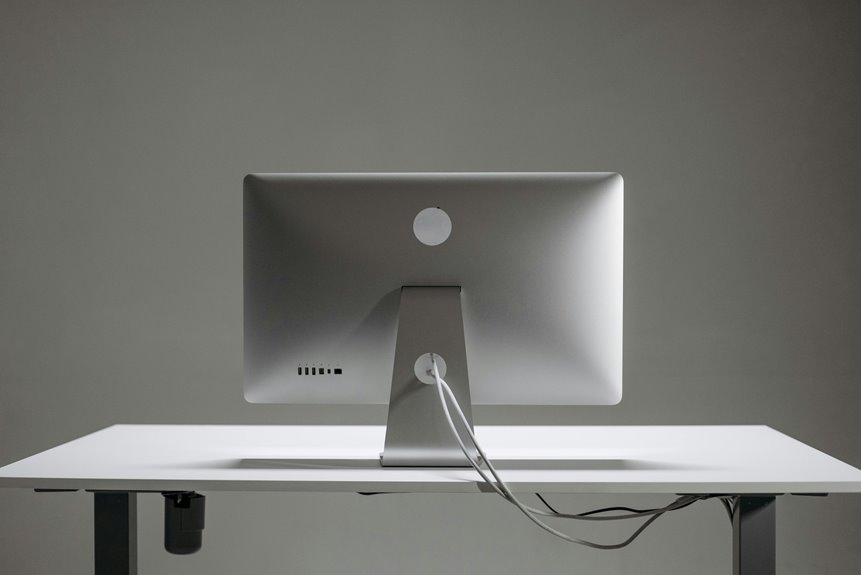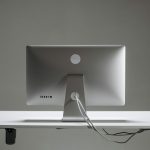If you've got a multi-monitor setup, you know how quickly cable clutter can spiral out of control. It can create distractions and make it hard to focus. By assessing your workspace layout, you can find ways to streamline those cables. But there's more to consider than just tidiness; the right approach can boost your productivity significantly. Let's explore effective strategies to reclaim your workspace and keep those cables in check.
Table of Contents
Key Takeaways
- Plan monitor placement and cable paths to prevent overcrowding and ensure easy access to ports.
- Use cable sleeves and clips to group and secure cables, reducing tangles and enhancing aesthetics.
- Choose high-quality, appropriately-sized cables and color-code them for easy identification and troubleshooting.
- Utilize built-in cable management features in monitor stands and desk grommets for a clean setup.
- Organize power strips with Velcro strips, label cords, and centralize outlets to maintain a tidy workspace.
Assessing Your Workspace Layout
Before you tackle cable management, it's essential to assess your workspace layout.
Start by identifying where your monitors, computer, and peripherals will sit. Make sure you have enough space for everything without overcrowding. Consider the distance between your devices; shorter distances usually mean fewer cables and less clutter.
Next, think about the cable paths—determine how cables will run from your devices to the power source. Visualize the layout and keep in mind potential obstacles like furniture and walls.
If you can, use a cable tray or raceway to control the flow. Finally, ensure that your setup promotes easy access to ports and connections, making it simple to plug and unplug devices as needed.
Choosing the Right Cables
Choosing the right cables is crucial for maintaining an organized and efficient multi-monitor setup. Start by identifying the types of connections your monitors and devices support, such as HDMI, DisplayPort, or VGA. Opt for cables that match these specifications to ensure optimal performance.
Consider the length of the cables; you don't want excess slack creating clutter. For a cleaner look, choose flat or braided cables that can be easily tucked away. Also, think about cable quality—investing in durable, high-quality cables can reduce wear and tear over time.
Lastly, color-code your cables if you have multiple connections. This simple step can help you quickly identify which cable goes where, making troubleshooting and adjustments much easier.
Implementing Cable Management Solutions
With the right cables selected, the next step is to implement effective cable management solutions to keep your multi-monitor setup tidy.
Start by mapping out your workspace and identifying cable routes. Use cable sleeves to group cables together, minimizing tangles and creating a streamlined look. Consider desk grommets to allow cables to pass through surfaces neatly.
If you're using a monitor stand, take advantage of built-in cable management features to conceal excess cords. Position power strips in less visible areas to reduce clutter and ensure easy access to outlets.
Finally, regularly check your setup to maintain organization, making adjustments as needed to accommodate any changes in your tech. Keeping things organized not only looks better but also improves your workflow.
Utilizing Cable Clips and Ties
Cable clips and ties are essential tools for maintaining order in your multi-monitor setup. By using these simple yet effective accessories, you can easily manage loose cables that often create a chaotic workspace.
Start by securing your monitor cables along the edges of your desk with clips, keeping them out of sight and reducing tangling. For longer cables, use ties to bundle them together, preventing them from becoming a tangled mess.
You can also attach clips to the wall or your desk to create designated paths for each cable. This not only enhances the aesthetic appeal of your area but also makes it easier to identify and access specific cables when needed.
Embrace these solutions for a cleaner, more organized workspace!
Organizing Power Strips and Outlets
While it might seem like a minor detail, organizing power strips and outlets can significantly enhance the functionality and aesthetics of your multi-monitor setup.
A tidy power management system not only prevents clutter but also ensures easy access to your devices. Here are three tips to keep in mind:
- Use Velcro Strips: Secure power strips to the back of your desk to keep them out of sight.
- Label Cords: Clearly label each cord to quickly identify which device it powers, saving you time and frustration.
- Create a Power Hub: Designate a specific area for all your power strips and outlets, centralizing connections and reducing tangles.
Incorporating Cable Management Accessories
To keep your workspace tidy, consider incorporating cable management accessories like clips and ties, under-desk trays, and Velcro straps.
These tools not only help organize your cables but also enhance the overall appearance of your setup.
Cable Clips and Ties
Organizing your workspace can significantly enhance productivity, and using cable clips and ties is a simple yet effective way to achieve that.
These accessories help you keep your cables neatly arranged, preventing tangles and distractions.
Here are three types of cable clips and ties you should consider:
- Adhesive Cable Clips: Stick these to your desk or wall to route cables neatly along surfaces.
- Velcro Straps: Reusable and adjustable, they allow you to bundle cables together without causing damage.
- Cable Ties: These provide a secure hold for cables, keeping them out of sight and organized.
Under-Desk Cable Trays
Under-desk cable trays can be a game-changer for anyone looking to declutter their workspace. By keeping cables off the floor and organized, you'll create a cleaner and more efficient environment. These trays mount easily under your desk, allowing you to neatly route all your wires.
Here's a quick comparison of different types of under-desk cable trays:
| Type | Pros | Cons |
|---|---|---|
| Metal Tray | Durable, sturdy | Can be heavier |
| Plastic Tray | Lightweight, affordable | May not hold heavy cables |
| Adjustable Tray | Customizable space | Installation complexity |
Using an under-desk cable tray not only enhances aesthetics but also prevents cable damage, ensuring a smooth work experience. You'll appreciate the difference it makes!
Velcro Straps and Organizers
While managing multiple cables can feel overwhelming, using Velcro straps and organizers can simplify the process significantly.
These handy tools help you keep your cables tidy and accessible, making your workspace look neat and professional.
Here are three ways you can use Velcro straps and organizers effectively:
- Bundle Cables: Group similar cables together using Velcro straps to prevent tangling and confusion.
- Cable Routing: Use Velcro organizers to guide cables along the edge of your desk or wall, keeping them out of sight and minimizing clutter.
- Adjustable Lengths: Velcro straps can be easily adjusted for various cable lengths, ensuring a snug fit without excess slack.
With these simple solutions, you'll create a more organized and efficient multi-monitor setup.
Maintaining Your Setup Over Time
As you continue to use your multi-monitor setup, it's essential to regularly assess and maintain the cable management system you've established. Cables can shift, become tangled, or even wear out over time. Schedule routine checks to ensure everything's in order and replace any damaged cables. Consider updating your organization methods with new solutions if you find your current approach isn't working.
Here's a quick maintenance checklist to help you stay on top of things:
| Task | Frequency | Notes |
|---|---|---|
| Inspect cables | Monthly | Look for wear and tear. |
| Tidy up cables | Weekly | Reorganize if they get messy. |
| Clean workspace | Bi-weekly | Dust and debris can accumulate. |
| Replace damaged cables | As needed | Don't wait until they fail. |
| Evaluate setup | Quarterly | Adjust for any new devices. |
Frequently Asked Questions
How Do I Hide Cables Behind My Monitors Effectively?
To hide cables behind your monitors effectively, you can use cable clips, adhesive hooks, or cable sleeves. Arrange the cables neatly and secure them to the wall or the monitor stands for a clean look.
What Tools Do I Need for Cable Management?
You'll need cable ties, clips, sleeves, and perhaps a cable management box. A measuring tape helps for precise lengths, while adhesive mounts can keep cables in place. Don't forget scissors for trimming any excess!
Can I Use Colored Cables for Better Organization?
Yes, you can definitely use colored cables for better organization. It helps you quickly identify which cable connects to which device, making your setup cleaner and more efficient. You'll appreciate the clarity and ease of maintenance!
How Often Should I Reorganize My Cable Setup?
You should reorganize your cable setup whenever you notice tangling or if your needs change, like adding new devices. Regular checks every few months can help keep everything tidy and functional, making your space more efficient.
Are There Eco-Friendly Cable Management Options Available?
Yes, you've got eco-friendly options! Look for biodegradable cable sleeves, recycled materials, or reusable ties. These choices reduce waste while keeping your workspace tidy, so you can feel good about your setup and the environment.




